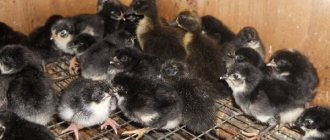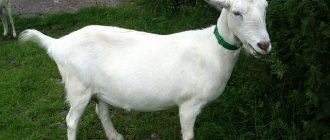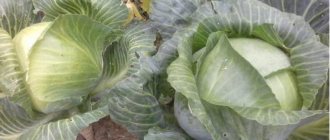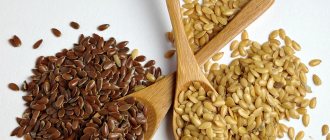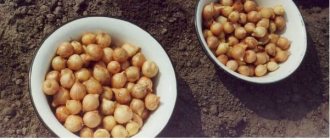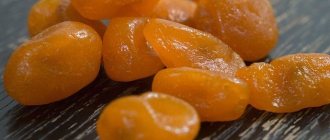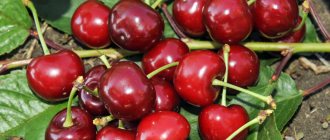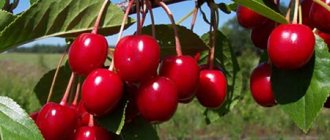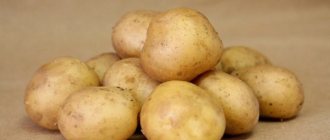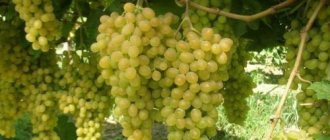Over the past half century, scientists have created many universal poultry hybrids. They are popular with private farm owners because they provide eggs and meat at the same time. Chickens master gray - meat and egg cross, characterized by undemanding food supply and care. Those who are now choosing between broilers and layers will find it helpful to learn more about birds from Hubbard.
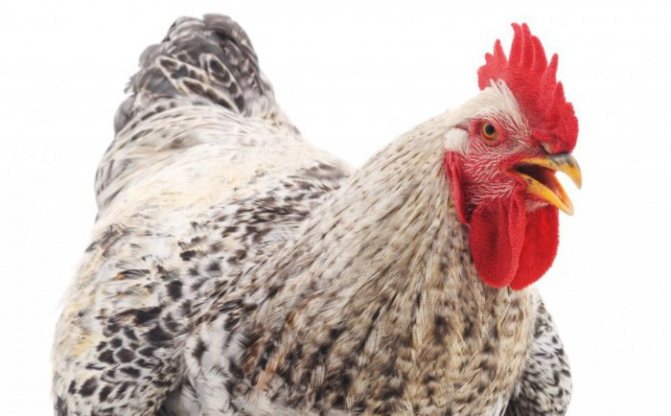
Rooster master gray
Origin of the cross
The Master Gray hybrid was created internationally, which has opened branches in the United States of America, Germany, Hungary and France. It is not known exactly in which country the breeding work was carried out. Presumably, in France, where the meat and egg cross was first introduced to the world and gained recognition.
The hybrid was created on the basis of redbro chickens. Scientists wanted to get a productive, versatile chicken, famous for its rapid growth and high egg productivity. When working on the breed, breeders focused on creating the ideal chicken for private farms.


Master gray hybrid was created on the basis of redbro
The result exceeded their expectations - the Master Gray breed combines the best qualities of laying hens and meat hens. Its representatives are undemanding to care and food supply and have strong immunity and vitality. In the course of breeding activities, 2 varieties of poultry were obtained:
- master gray M;
- master gray S.
Description of hens of the master gray breed
The photo shows the chicken master gray. It is a large bird with gray-white plumage. The feather cover is thick and dense, on the chest and abdomen its shade is lighter. Dark feathers prevail in the neck area, on the tips of the wings and in the tail.
Reference. In terms of body type, Master Gray hens resemble the foxy chick family line. The only difference is in color - the Hungarian cross has a fiery red plumage.
Exterior description with photo
Outwardly, the bird is unremarkable. Its features are high growth, dense build, powerful paws.
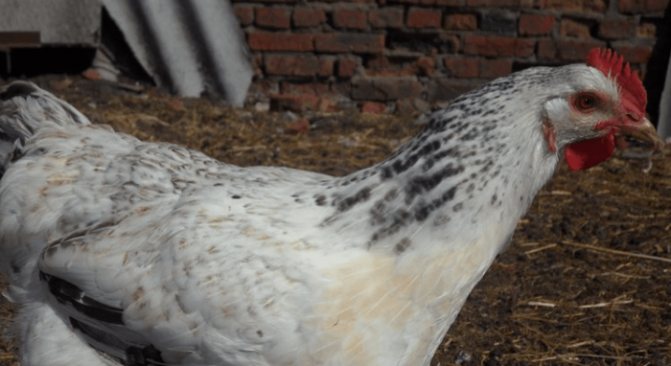

Laying hen master gray
Exterior signs of a rooster master gray:
- one-year-old weight - 5–6 kg;
- medium-sized head with bright red leaf-shaped crest;
- earrings are round, small in size, white lobes;
- beak is yellow, wide, bent down at the end;
- the red skin of the face is hidden under the abundant plumage;
- the iris of the eyes is orange;
- the neck is long, massive, curved;
- the body is elongated, knocked down, with well-defined muscles;
- the back is wide;
- convex chest;
- thighs and tibiae fleshy, strong metatarsus with yellow skin;
- the tail is short.
Layers are slightly smaller - up to 4 kg of live weight. They differ from roosters in their rounded body shapes. The chest is less pronounced, the abdomen is full. Females appear to be more squat.
Temperament
Feathered are characterized by a calm disposition. Despite their gigantic size, roosters do not like to show superiority and rarely become parties to conflicts. Laying hens get along with each other, hardly make any noise. Birds react normally to a change in environment, quickly get used to a new owner.
Productive qualities
Master gray meat and egg cross shows high productivity in both directions. From an economic point of view, this is a very successful breed for a backyard.Interestingly, weighty chickens mature early - they begin to lay at the age of 4 months. For a year, the laying hen gives 250 eggs weighing up to 70 g, and the record holder - up to 300 units of production.
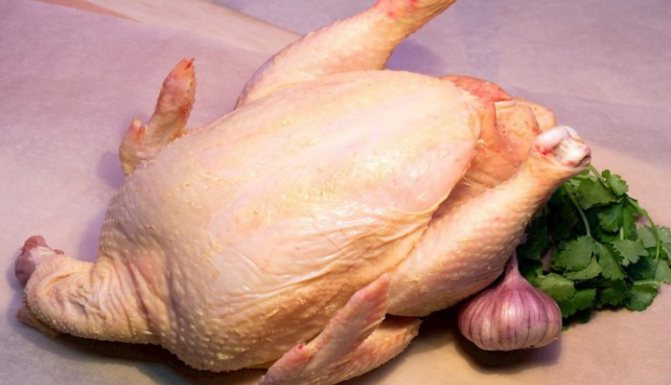

Master gray chickens have tender meat
The growth rate of the cross is average. Males weigh 6 kg at the age of one year, but they are sent for slaughter at 4–5 months. At this time, the meat is more tender and juicy, and the weight of the carcass is 2.5–3 kg. The representatives of this breed have a well-developed chest, there is a lot of dietary white meat in it.
Reviews of poultry farmers
Leonid, 44 years old, Kungur
It is not the first year that I have been dealing with chickens of this hybrid. It seems to me that for a small home garden, Master Gray is the ideal option. These chickens are versatile because they have high meat and egg productivity. Each layer produces about 200 eggs per year. There is a lot of meat in carcasses. In terms of taste, it is excellent. The good news is that the birds require minimal care and standard feeding.
Ekaterina, 39 years old, Omsk
If you have never kept chickens on the farm and want to try yourself in this business, but do not know where to start, take Master Gray chickens, you will not regret it. They are unpretentious in the content, and what is not less important - in nutrition. These are the moments that are often the most difficult for poultry farmers. Chickens grow large, eggs lay regularly, usually every other day. The bird is beautiful in appearance, calm and highly productive both in egg and meat - really versatile.
Alexander, 35 years old, Volgograd
Absolutely unpretentious chickens. A good option for a household. I keep a small livestock in my summer cottage. I provide all seven with fresh eggs, as each hen stably lays 3-4 eggs per week. Unfortunately, you cannot breed them yourself. But, overall, an excellent breed that can be recommended even for beginners.
Irina, 34 years old, Samara region
Master Gray is a colored broiler, but at the same time it grows for at least 4 months. What is important, the meat does not become tougher at such feeding times. We gave them food for the broths. By the age of four months, our birds were at least 3.1 kg of net weight! They didn’t leave the egg, as we only grow it seasonally.
Advantages and disadvantages of cross master gray
Chickens of the Master Gray breed are appreciated not only for their high productivity, but also for other qualities:
- early onset of oviposition;
- undemanding to conditions of detention and food supply;
- phlegmatic character;
- stress tolerance;
- endurance;
- high rates of preservation of young animals - 96–97%;
- great taste of meat;
- good presentation of carcasses;
- strong immunity.
The main disadvantage of Master Gray chickens is that they cannot be bred at home.... Descendants of hybrids lose most of their parental traits already in the first generation. The company that supplies these chickens does not disclose what breeds of birds are used to breed the cross.
Some consider slow weight gain as a disadvantage of the breed, comparing master gray chickens with broilers. However, birds belonging to different areas of productivity should not be placed on the same level. Only meat is obtained from broilers, and they need special conditions for keeping and feeding. In contrast to meat crosses, Master Gray chickens bring a double benefit - they also give a lot of eggs, while the birds do not need complicated care.
Features of caring for chickens
Master Gray chickens can be kept on the floor or in cages. The first option is suitable for farmers who have a spacious barn and walking area. Large birds need a lot of space. The recommended stocking density of the poultry house is 2 birds per 1 m2.
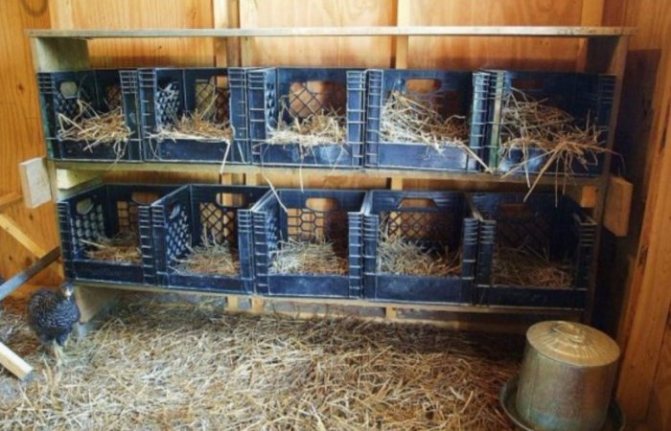

Barn arrangement
Cage keeping implies the rearing of chickens without range.In this case, the birds are limited in movement, therefore they gain weight faster, but the quality of the meat at the same time decreases - the carcasses contain more fat.
Chicken coop requirements
Those who want to grow Master Gray chickens on their backyard will have to build a warm poultry house. In the northern regions and the middle lane, it is very cold in winter, so it is necessary to provide for the possibility of heating the barn. Recommended temperature for cross is + 8… + 26 ºС.
The chicken coop should be located in an elevated place. It is imperative to have a window so that natural light can enter the room. Laying hens are kept on a thick bed of straw or a mixture of sawdust and peat. As it gets dirty with droppings, it is turned over. Once a month, it is recommended to lay a layer of fresh underlayment on top of the old one.
Representatives of the Master Gray breed cannot fly due to their heavy weight. Perches for them are installed at a height of 60 cm. For the convenience of ascent and descent, gentle ladders are provided. For 1 adult bird, 40 cm of the length of the pole is allocated.
For laying hens, nest boxes are needed - 1 piece for 3-4 birds. It is advisable to equip them with egg receptacles, otherwise massive and clumsy chickens will crush the shell. A feeder, containers for gravel, shell rock and drinkers are installed on the floor.


Ventilation in the chicken coop
Farmers pay special attention to maintaining the correct indoor climate. The health and productivity of birds depends on this. It is important to take care of good air exchange. During the decomposition of the droppings, vapors of ammonia and hydrogen sulfide are released, due to their high concentration in chickens, immunity decreases. Poor ventilation is a common cause of respiratory diseases.
Attention! Ammonia vapor accumulating in the air causes night blindness in chickens.
Walking yard
Daily walks have a beneficial effect on the productivity of poultry. On the street, birds receive a portion of ultraviolet radiation, peck at fresh greens, look for worms and beetles. A walking area is equipped next to the poultry house and connected to it with a manhole. For Master Gray hens, a high hedge is not needed - their wings are poorly developed. On the territory of the corral, a trough with a sand-ash mixture is installed for bathing chickens.


Aviary for chickens
With the onset of spring, birds spend most of the day walking. They leave the coop after the morning feed and return home in the evening. In winter, chickens also need to be outdoors, but walks should not be long. When the temperature drops to -5 ºС or a strong wind blows, it is better for birds to stay in the house, otherwise they will freeze the ridges.
How does molting affect productivity?
Molting begins in October. Old feathers fall out, and new ones grow back. At this time, bald spots appear on the body of layers, which makes them freeze. Changing feathers strikes the body's immune system, since most of the nutrients are expended on the formation of a new cover. During this period, chickens need protection from dampness, drafts and good nutrition. The diet of birds is enriched with vitamins and microelements.
Reference. During molting, egg production drops by about 40%. Productivity is restored after 2 months.
Feeding recommendations
Representatives of the Master Gray breed will fully reveal their productive qualities if they are provided with adequate nutrition. The birds do not have to be fed with expensive compound feed and premixes, like broilers. The basis of the diet is made up of grain mixtures consisting of millet, millet, barley, buckwheat, corn.
Attention! Master gray chickens should not be overfed - they are prone to obesity.
In addition to grain, the birds are given beans - peas, lentils, which contain protein. Vegetables and greens are sources of vitamins. Laying hens are happy to eat carrots, fodder beets, cucumbers, pumpkin.In summer, poultry feeds most of the day on grass - shoots and leaves of nettle, dandelion, alfalfa, plantain. Garden owners give the birds tops.
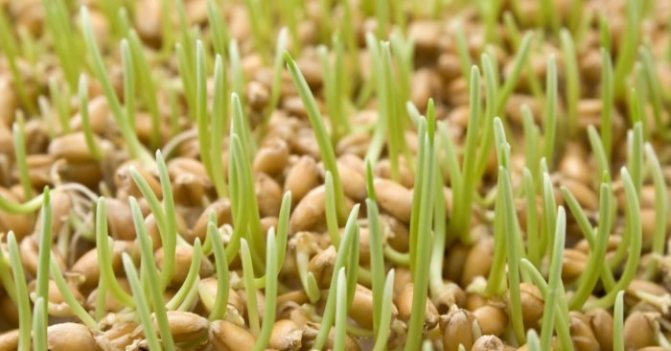

Chickens love sprouted grain
The bird menu includes useful additives that serve as a source of minerals - chalk, yeast, sunflower cake. For the strength of the shell, birds must receive shell rock, there is a lot of calcium in it. To replenish the lack of vitamins in winter, birds are given grain seedlings and herbal granules.
Feeding frequency depends on the season. In summer, the hens are given grain in the morning and in the evening, because most of the time they are on the street and there they find food for themselves - worms, slugs, weeds. In winter, hens are fed 3 times a day - at lunchtime, farmers treat them to wet mash. They add vegetables, herbs, bone meal, chalk. The diet of chickens is enriched with fish oil to prevent rickets.
Disease prevention
With good care, Master Gray chickens do not get sick, they are famous for their stable immunity. If the farmer does not follow the recommendations for feeding and caring for the poultry, the livestock may suffer from parasitic diseases, vitamin deficiencies and colds.
Unsanitary conditions in the hen house often cause infection of birds with ticks that infect the paws of birds. This disease is called Knemidocoptosis and is accompanied by the appearance of ugly bumps on the legs. The pathogens gnaw passages in the skin and lay eggs there, which causes concern to the laying hen.
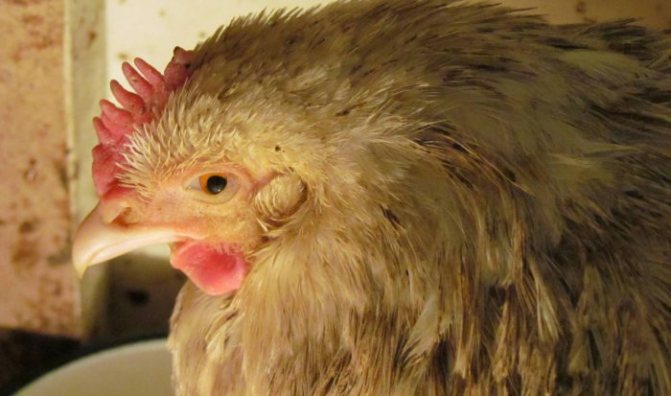

A sick chicken sits to the side and giggles
Dampness and draft are the worst enemies of poultry. In such conditions, chickens weaken and become vulnerable to viral and bacterial infections - mycoplasmosis, salmonellosis, pasteurellosis. A daily inspection of the livestock will help you to see in time that the laying hen is sick. Signs of ailment:
- lethargy, depressed appearance, loss of appetite;
- the bird sits to the side, ruffled, its eyes are half-closed;
- thirst;
- discharge from the eyes - purulent or frothy;
- cough, wheezing;
- blanching of the crest;
- impaired coordination of movements;
- diarrhea - white, green, frothy, bloody.
Attention! If such symptoms are found, the farmer should isolate the hen and invite a veterinarian. It is impossible to hesitate - infectious diseases spread quickly.
Feeding
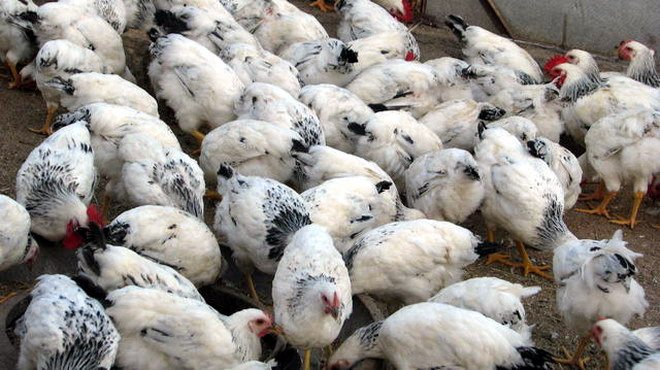

To feed poultry, it is necessary to use high-quality feed that will meet all calorie requirements. Feeding of an adult bird in summer is carried out in the morning and in the evening, and in winter also during the day.
If chickens are fed in the same way as broilers are fed, then they are not given feeds that are very rich in protein. If the males are fattening, then food with proteins is given to them every day, at the same time. So birds gain weight and muscle mass faster.
The classic feeding option is giving compound feed 2 times a day with the addition of greens and vegetables.
Such a diet is completely balanced, and the bird fully gains weight on it and shows high egg production results. Also it will be useful to add fish bone meal to the diet, and in winter and grass flour. Without them, the health of the bird may deteriorate somewhat, which can be determined by the deterioration of the feather and the drop in egg production.
When raising chickens for the first weeks, you should give preference to compound feed, as this will allow you to get strong young growth.
Feeding pets can be fed with grain and vegetable, fish and meat waste. Whey and cottage cheese are useful for chickens, it is advisable to feed them once every 5 days.
The owner decides which diet to choose for the bird, depending on the capabilities and conditions of detention. When growing in cages, compound feed should be preferred.
Poultry water should be constantly in sufficient quantity and always clean and fresh.
Features of breeding crosses
Master Gray is a hybrid, not a breed, so it will not work to breed them at home. The offspring obtained by crossing a rooster and a hen from this line will lose their parental characteristics. To grow crosses on your farm, you will have to buy young animals or hatching eggs from the poultry farm.
Reference. Some farmers breed Master Gray roosters with Orpington, Raspberry or Australorp chickens to produce meat chickens. However, in this case, egg production will suffer.
Growing young animals
Master gray chicks are born with light, almost white, down. Dark spots are visible on the tips of the wings and on the head. Young animals are distinguished by their vitality - in the first 7 days of life, losses do not exceed 3 heads out of 100.
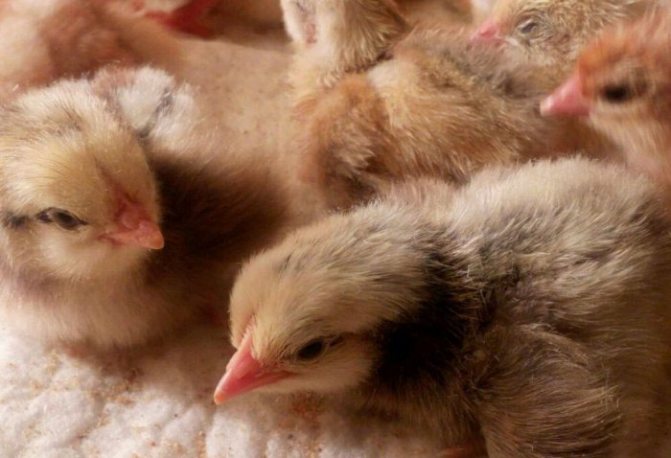

Chicks master gray
Newly hatched chicks are allowed to dry and then transferred to a brooder. The temperature inside is kept at about +30 ºС. It is lowered gradually, by 2 divisions a week, accustoming the younger generation to external conditions.
It is important to keep the inside of the chick house clean. The litter must remain dry. In the first days of the chicks' life, farmers advise using cotton cloth rather than sawdust. It absorbs moisture well and is easy to replace. When the kids grow up, wood shavings are placed on the floor.
The health of young animals depends on the quality of nutrition. Day-old chickens are given a hard-boiled egg. On the second day, green onions are mixed with it. Next, the kids are transferred to starting compound feed. Vegetables are gradually introduced into the diet - finely grated carrots, pumpkin, zucchini. Chickens love wet mash with steamed millet and herbs, cooked with whey.
Attention! Young animals should receive animal protein. It is recommended to give the birds boiled white fish and low-fat cottage cheese twice a week.
Analogs
In Russia, other breeds of chickens are also bred, the productivity characteristics of which are similar to the master gray cross. They are undemanding to care for, so they are suitable for home maintenance, for example:
- Redbro is a meat and egg hybrid from. Chickens with red plumage, lay about 270-300 eggs annually. Carcasses are large, fleshy with an average weight of 3–3.5 kg. Egg weight - 65-70 g.
- Pharma color. Chickens with a massive physique, well-developed breasts, strong legs. The weight of the rooster, which has reached maturity, is 4.5 kg, the laying hens - 3.5 kg Egg production - 250-275 eggs per year.
- Tetra-N - Hungarian cross from Babolna TETRA company. Feather color - red. The birds are famous for their massive carcass, juicy dietary meat and good egg production - 230-250 units of the product per year. The average weight of a chicken is 2.5 kg. The males are larger - 3.5 kg. The birds are easily adaptable and have a calm character.
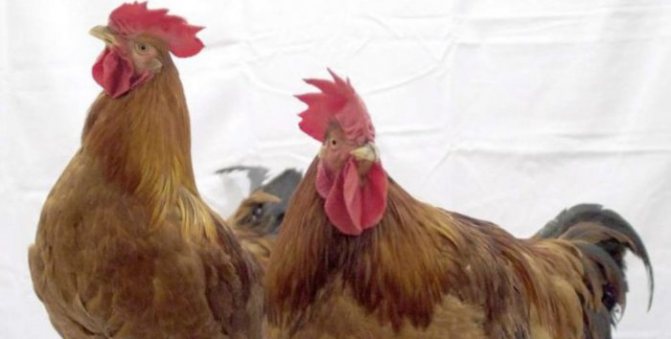

Chickens farm analogue cross master gray
Poultry farmers leave positive feedback on the French hybrid Master Gray. For many, this cross has become a favorite, because it combines the qualities of broilers and layers. Such chickens are indispensable in the farm - they provide the owner of the farm with tasty and nutritious meat and a large number of large eggs. Birds are appreciated for their unpretentiousness, good adaptive qualities and good health - they are easy to care for.
Appearance
Translated from English, gray means gray. The name is probably associated with the color of the plumage, chickens have an unusual color of feathers, white-gray. The edges of the tail and wings are painted in darker shades of gray, as well as darker feathers around the neck. On the back and abdomen, feathers are lighter, the pattern is poorly expressed. The crest is leaf-shaped, bright scarlet, the earrings are large, red. Large eyes, deep orange iris.
The skeleton is well developed, and the musculature is well developed. The birds are quite tall, the body is elongated, the chest and dorsal parts are wide. The body is massive, dimensional, chickens have a fat appearance. The tail is small, even in males. The legs are strong, the middle ones are colored yellow in length.

